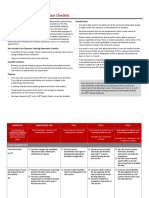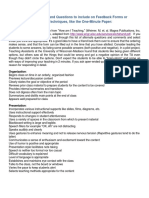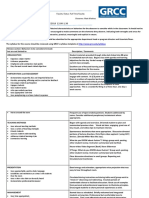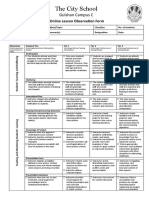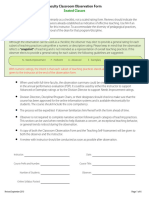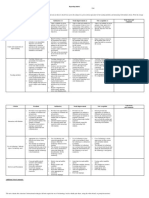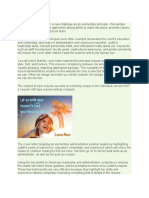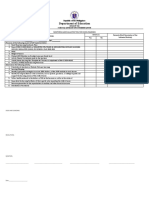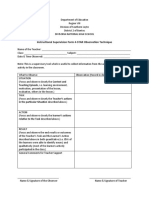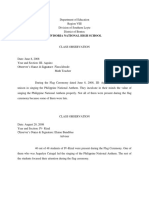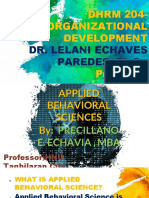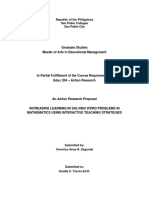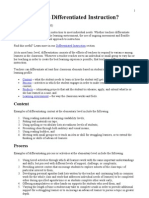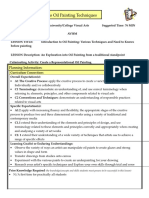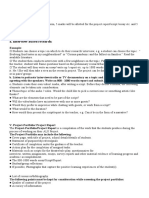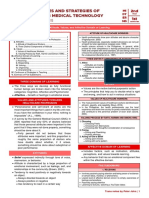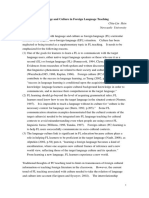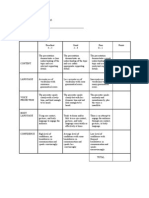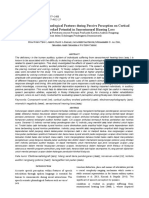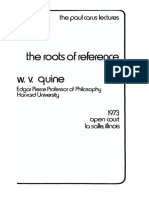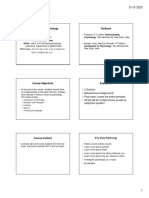OBSERVATION
SAMPLE
TEMPLATE
Checklist This form focuses on description regarding agreed upon items for
(criterion- observation based on the pre-observation meeting. Comments may be used
based) Form by the observer to explain their observation and to provide reflection and
additional insight. A sample format for these comments is as follows:
DURING DISCUSSION, THE INSTRUCTOR PAUSES AFTER ASKING QUESTIONS. ☐Yes ☐No
COMMENTS: Here, the observer may include, examples, further observations and when this observation occurred.
The following categories and items represent a number of possibilities for a departmental
or divisional form. Observers should select appropriate items for the observation. Not all
need apply in all teaching contexts - try to avoid rigid formulas regarding what “should” be
observed.
POSSIBLE ITEMS FOR CHECKLIST FORMS INSTRUCTIONAL MATERIALS
INSTRUCTOR ORGANIZATION F If used, videos, websites and other resource materials
have a clear purpose.
F The instructor states the relation of the class to the F Handouts or digital resources are appropriate in
previous one. number and subject.
F The instructor knows how to use the educational F The instructor gives assistance or insight into reading
technology needed for the class. or using assigned texts.
F The instructor posts class goals or objectives on the
board or a slide. INSTRUCTIONAL STRATEGIES
F The instructor gives specific instructional outcomes
for the course. F The instructor’s choice of teaching techniques is
F The instructor provides an outline of the organization appropriate for the goals.
of the class. F During discussion, the instructor pauses after asking
F The instructor conveys the purpose of each class questions.
activity. F The instructor acknowledges student contributions
F The instructor summarizes periodically and at the to discussion, helping students extend their
end of class or has the students do so. responses.
F The instructor revisits objectives at the end of class. F The instructor keeps discussion on track or facilitates
F Students are made aware what preparation (readings small group discussion.
or other assignments) they should complete prior to F The instructor mediates conflict or differences of
the next class. opinion, and encourages students to do the same.
F The instructor demonstrates active learning
techniques.
20.
�F The instructor provides explicit directions for active F The atmosphere of the classroom is participative.
learning tasks. F The instructor is available before or after class.
F The instructor allows enough time to complete F The instructor pays attention to cues of boredom
active learning tasks, such as collaborative work. and confusion.
F The instructor specifies how active learning tasks will F The instructor provides students opportunity to
be evaluated. mention problems/concerns with the class, either
F The timing of classroom activities considers attention verbally or in writing.
spans. F The instructor models good listening habits.
F The instructor relates class to course goals, students’ F The instructor demonstrates flexibility in responding
personal goals, or societal concerns. to student concerns or interests.
F The instructor offers “real world” application. F The instructor is sensitive to individual interests and
F The instructor helps students apply theory to solve abilities.
problems.
CLARITY
CONTENT KNOWLEDGE
F The instructor defines new terms or concepts.
F The instructor’s statements are accurate according to F The instructor elaborates or repeats complex
the standards of the field. information.
F The instructor incorporates current research in the F The instructor uses a variety of examples to explain
field. content.
F The instructor identifies sources, perspectives, and F The instructor makes explicit statements in order to
authorities in the field. draw student attention to certain ideas.
F The instructor communicates the reasoning process F The instructor pauses during explanations to allow
behind operations or concepts. students to ask questions.
F The instructor corrects bias in assigned materials.
INSTRUCTION IN LABORATORIES, STUDIOS OR FIELD SETTINGS
PRESENTATION
F Experiments/exercises are well chosen and well
F The instructor can be seen and heard. organized.
F The instructor avoids extended reading from notes F Procedures/techniques are clearly explained/
or texts. demonstrated.
F The instructor varies lecturing with active learning F The instructor is thoroughly familiar with
techniques. experiments/exercises.
F The instructor speaks at a pace that allows students F The instructor is thoroughly familiar with equipment/
to comprehend what is said. tools used.
F The instructor uses appropriate examples, metaphors F Assistance is always available during experiments/
and analogies. exercises.
F The instructor uses humour appropriately. F Experiments/exercises are important supplements to
F The instructor is enthusiastic about the subject the course.
matter. F Experiments/exercises develop important skills.
F Experiments/exercises are of appropriate length.
RAPPORT WITH AND RESPONSIVENESS TO STUDENTS F Experiments/exercises are of appropriate level of
difficulty.
F The instructor addresses students by name, as F Experiments/exercises help to develop confidence in
possible. the subject area.
F Delivery is paced to students’ needs. F The instructor provides aid with interpretation of
F The instructor provides feedback at given intervals. data.
F The instructor uses positive reinforcement. F The instructor’s emphasis on safety is evident.
F The instructor incorporates student ideas into the F Criticism of procedures/techniques is constructive.
class. F The instructor works well with student and other
F The instructor encourages students to build on each parties in the setting.
other’s comments and ideas. F Clinical or field experiences are realistic.
21.
�IMPACT ON LEARNING F Instructor conveys openness and warmth and
encourages students to interact with others the
F The instructor helps develop critical thinking skills same way.
and problem-solving ability. F Instructor provides text, resources and learning
F The instructor broadens student views. materials in the classroom that reflects diversity
F The instructor encourages the development of of culture, ethnicity, faith, and language, and
students’ analytic ability. differences in socioeconomic status, physical ability
F The instructor fosters respect for diverse points of and family structure.
view. F Instructor uses resources that present both local and
F The instructor helps students develop awareness of global images and perspectives.
the process used to gain new knowledge. F Instructor uses technology to provide additional
F The instructor stimulates independent thinking. visual, oral, aural and/or physical supports for
students who need them.
CREATING AN INCLUSIVE CLASSROOM F Instructor uses instructional strategies that reflect
diverse learning styles.
F Instructor creates an equitable and inclusive F Instructor uses a variety of assessment tasks so that
classroom that respects gender differences, diverse students with different learning styles can achieve
ethnocultural and faith communities, family success.
structures, student abilities/needs and differences in F Instructor provides accommodations for students
socioeconomic status. who require extra time or additional explanations.
F Instructor conveys the belief that all students can
learn and succeed. Items are adapted from Chism (2007) and University of
Minnesota Peer Review of Teaching Guide (2009).
22.






